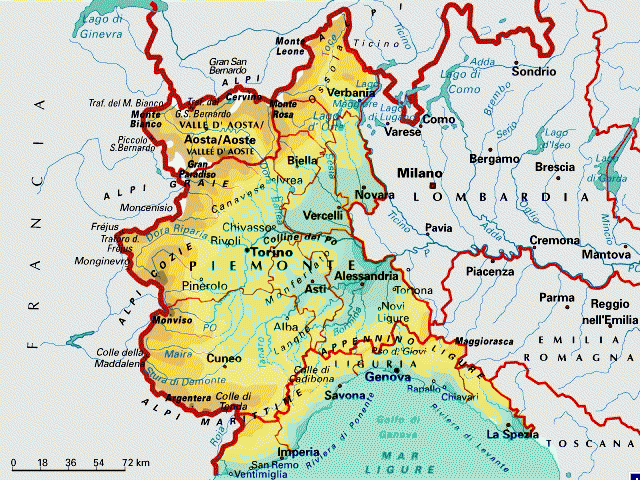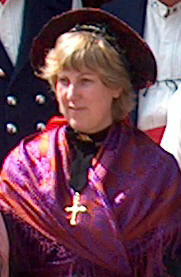Hello all,
Today I will continue my overview of the Folk Costumes of the Paese, or Land of Piedmont, or Piemonte. Here is our map of the provinces of Piedmont.
Today I will be covering the province of Turin, or Torino.
Once again, here is our linguistic map of the Region. You can see that, besides the Italian dialects/languages of Piemonteis and Lombard, This region includes speakers of Occitan [Provencal], Arpitan [Franco-Provencal], and Walser German.
Province of Turin - Torino
https://en.wikipedia.org/wiki/Metropolitan_City_of_Turin
The Province of Turin is now officially 'The Metropolitan City of Turin', which does not just include the City of Turin, but the entire area. It borders Cuneo on the south, France on the west, Aosta to the north, and Vercelli and Biella to the east.
The bulk of the surviving Folk Costumes are from the mountains. I will proceed clockwise from the southwest.
Occitan Zone
This includes the three so called Waldensian Valleys, and the uppermost part of Susa Valley, upstream from the town of Susa.
Valadas Valdesas - Val Pellice and Val Germanasca
https://it.wikipedia.org/wiki/Valli_valdesi
Generally, Val Chisone is also considered to be one of the Waldensian Valleys, but the costumes there are distinct. The Waldensians are now considered to be a pre-Reformation Protestant group that dates to the 12th cent. They started in this region, and this costume is considered to be a badge of identity. In fact, all the women in these valleys wore this costume, not just the Waldensians, but it has fallen out of use by Catholic women. I have found no systematic difference between the costume of Val Pellice and Val Germanasca.
This first image is a plate from Calderini, showing a well off woman from Torre Pellice.
The coif has a more gathered and puffed peak than the one found further south in Val Varaita.
This image is labelled Val Germanasca. Perhaps the difference is that they may wear shawls that are not white.
Val Chisone - Usseaux and Fenestrelle
https://en.wikipedia.org/wiki/Val_Chisone
Val Chisone is a large valley, and has two distinct costumes, distinguished mainly by the coif. This costume is found in the lower valley, especially in the area around the towns of Usseaux and Fenestrelle. The coif is a confection of silk ribbons and bows in white or black, very reminiscent of the one worn in Orelle in the Maurienne Valley in Savoie, France. [which is only two valleys away]
The men in this area have a tradition of sword dancing, which is very similar to traditions found as far as Bohemia and England. They use a special costume, or 'kit', as is generally the case.
Upper Val Chisone - Pragelato
https://en.wikipedia.org/wiki/Pragelato
The Val Chisone makes a sharp bend just upstream from Usseax, and this costume is found in the upper valley, the main town of which is Pragelato. The main distinguishing feature is a football shaped cap which sits on the back of the head.
Here again is Calderini's plate of this costume.
The shape of the cap is not really visible from this angle, it is better appreciated from the front.
Or the back. On the right we see a woman from Usseaux.
As is common in most places, small children wear different caps.
Here is the website of a group which specializes in the Costumes and dances of Val Chisone and Val Germanasca, 'La Teto Alt'.
http://www.folkpiemonte.it/gruppolatetoaut.html
Upper Susa Valley - Oulx
https://en.wikipedia.org/wiki/Susa_Valley
The Susa valley is located in the northwest corner of Turin Province, and is bordered on the west and north by France, specifically the Maurienne valley of Savoie. Upstream from the town of Susa, the population speaks Occitan. The main town of this area is Oulx. Again, the main distinction of the costume is the coif.
Guardia Piemontese
https://en.wikipedia.org/wiki/Guardia_Piemontese
In the 12th and 13th cent, some of the Waldensians of Val Pellice emigrated and formed a colony in Calabria. Today this area is called Guardia Piemontese. It is still an enclave of the Occitan Language, but the Waldensian sect was supposedly wiped out in 1561. The Folk Costume has been much influenced by the Calabrians. Note the flag of Occitania in this first image.
Arpitan or Savoyard Zone
From this point, the valleys to the east are populated by speakers of Arpitan [Franco-Provencal]
Central Val Susa - Val Cenischia
https://it.wikipedia.org/wiki/Val_Cenischia
This costume is worn in the short side valley of Cenischia, and the towns of Venaus and Giaglione in the main Susa valley. In this area, the coifs are black.
This following photograph is on the internet labelled Moncenisio, at the head of the valley. There must have been some mixup, because this is in fact the costume of Formazza, from the Province of Verbano-Cusio-Ossola. You can easily see the difference.
The local Sword Dance Group from Venaus.
A video of the Sword Dance of Venaus. This is a different type of sword dance than the one done in Fenestrelle.
https://www.youtube.com/watch?v=crz56__Qddw
VallI di Lanzo - Lanzo Valleys
https://en.wikipedia.org/wiki/Lanzo_Valleys
These three valleys lie at the headwaters of the river Stura de Lanzo. Above the city of Lanzo, the valley divides into three. These valleys are commonly lumped together, and the costume is similar in all of them.
Valle di Viù
https://it.wikipedia.org/wiki/Valle_di_Vi%C3%B9
The first valley is that of Viu'. It is the southernmost of the three Lanzo valleys
Again, the costume is quite similar except for the coif. Here is Calderini's plate of this costume.
The coif is rather small, sits high on the head, has a large bow in front, and on special occasions, has a veil worn over it.
Some images show a black hat worn instead.
Val d'Ala
The middle valley. Two of the towns in this valley are Balme and Ala di Stura.
Here are a couple pictures from Ala di Stura.
These images are from Balme.
A video of a band playing music from this area. The dancers look to be from Balme. The video spends far too much time looking at the musicians.
https://www.youtube.com/watch?v=6Pt0DCMcBl8
Here are a few images from the 1930 wedding of Prince Umberto. It seems that they must be from this area.
In this image, you can see that the last 4 women on the right are from different valleys.
Just a couple more images that are not specified as to which valley.
A short promotional video about this area.
https://www.youtube.com/watch?v=c8iVevTrCGU
Orco Valley
https://en.wikipedia.org/wiki/Orco_Valley
This lies north of the Lanzo valleys and south of Aosta. The main town is Ceresole Reale.
I have found only a couple of images of the costume of this valley.
Val Soana
https://it.wikipedia.org/wiki/Val_Soana
This valley lies to the east of the Orco Valley, and part of it lies within Gran Paradiso National Park. The Soana river flows south from the border of Aosta. The main town of this region is Ronco Canavese.
Here is Calderini's plate of the costume of this valley. She seems to be wearing a folded cloth on her head. A couple of the older images show something similar, but more recent images all show the women bareheaded. There does not seem to be a coif native to this valley.
This video shows a 'fashion show' featuring the costume of this valley, with some music and dancing at the end. At the beginning, of course, are long speeches.
https://www.youtube.com/watch?v=EuJn2Um-iKU
This is the end of the Arpitan Zone
Carema
https://en.wikipedia.org/wiki/Carema
This town lies in the extreme northeast corner of Torino Province, just outside of Aosta.
There is a plate by Calderini of the costume of this town, and all the other images which I found seem to be imitations of it.
Maglione
https://en.wikipedia.org/wiki/Maglione
This town lies south of Carema, close to the eastern edge of Torino Province. They have a tradition of Processing in local costume with towers on their heads on the local Saint's day. You may have noticed a couple of similar images in the above valleys.
La Collina Torinese
https://it.wikipedia.org/wiki/Colline_del_Po
There is a place east of the city of Turin which is called Collina Torinese. Thisis the subject of this old print, which simple reads, Contadine della Collina, east of the City.
If we look at the photographs of the different Piedmont groups which attended the wedding of Prince Umberto in 1930, we find these two, in which the people seem to be wearing the same costume.
A couple more such prints exist, showing the costume of various locations around the Province.
This is labelled Settimo Vittone, which lies just south of Carema.
This print shows three different costumes, Contadina di Chiaverano, contadino di Bolengo, contadina di Montalto. These three towns are northeast of Turin, south of Settimo Vittone.
Turin City
The city itself once had a particular costume as well. Here are some old prints and modern reenactors showing the costume.
They need to take another look at the old prints and redesign the headdresses.

This video shows stills of many of the valleys which I have talked about in this article.
https://www.youtube.com/watch?v=-PL7qML1Hnk
Thank you for reading, I hope you have found this to be interesting and informative.
Roman K
email: rkozakand@aol.com

































































































































































Your fashion items are really pretty. Your blog is very helpful for fashion lovers. We want updates from your blog regularly.
ReplyDelete